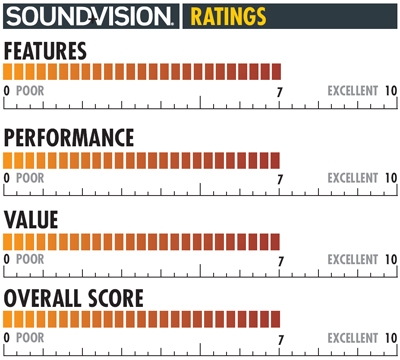Sharp LC-52LE700UN 52-Inch LCD HDTV Page 2

PERFORMANCE
With its dark interiors, night scenes, and colorful weapons and uniforms, the Blu-ray Disc of G.I. Joe: The Rise of Cobra really showed off the tuned-up Sharp's capabilities. The opening scene, in which a captured 17th-century Scottish weapons dealer gets a very unpleasant fitting for a red-hot cast-iron face mask, takes place in a dark stone torture room lit by lanterns and an open coal fire. The Sharp's deep blacks and good rendition of shadows on this scene brought out gobs of detail. In one shot, the texture of the prisoner's black leather vest and its rows of brass buttons, the fine strands in his dark, stringy hair and beard, and the dark grain of the wooden chair he was strapped to were all readily visible in the dim shadows.
The next scene flashes forward several hundred years and begins with a shot of grass and trees that showed off the Sharp's natural color rendition. The camera then cuts to a NATO conference room where members of the military are getting briefed on a new secret weapon by the movie's villain, arms manufacturer James McCullen (Christopher Eccleston). As the camera pulls out to show McCullen's face, the perfectly rendered close-up of his red paisley tie, and the neutral-gray colors of his two-tone suit convinced me that my adjustments had brought the Sharp's color right in line. Meanwhile, the fine stripes and ribbing in the fabric showed that the TV's 1080p screen was delivering its full resolution. Skin tones also looked good, with McCullen's slightly tan complexion nicely delineated against the ruddier face of good guy General Hawk (Dennis Quaid) and the pale, smooth skin of his beautiful blond assistant.
Despite the good pictures I was seeing, I noticed that on many darker scenes, this movie's letterbox bars looked washed out - an effect that was at odds with the excellent blacks and strong shadow detail in the active part of the image. To get to the bottom of things, I set up a Panasonic TCP58V10 58-inch plasma I had on hand and viewed the same images side by side on the two TVs.
The comparison proved instructive. In scene after scene from G.I. Joe and the World War II docu-thriller Valkyrie, the Sharp mostly went toe to toe with the plasma on black levels, and in several scenes it showed more natural punch in the brightest highlights. Only on the most challenging dark scenes did the Panasonic deliver an extra measure of shadow detail or depth thanks to its purer blacks.
But the difference in the rendering of the black letterbox bars between the sets was obvious. On scenes that were bright or contained bright elements, the bars on each set looked the same or very close, sometimes even disappearing into the blackness of both TVs' bezels. But when the Sharp was displaying darker images, the black letterbox bars seemed to increase in brightness. I also noticed that with the Sharp, even a slight deviation from an off-center viewing position - equivalent to a single seat-width on a couch at an 8-foot viewing distance - caused the blacks to lose some depth.

BOTTOM LINE
Since Sharp is a sponsor of Major League Baseball, I was hoping it would hit this one out of the park. Turns out it has scored a triple, or maybe a solid double with a stolen base. The LC-52LE700UN is a great-looking TV with truly deep blacks, good color, and smooth image processing that puts it among today's better LCDs. But it took an ISF-style calibration to get it looking that way, and the set's narrow viewing window, along with the occasionally odd black-level behavior I observed, gave me some pause. In the end, though, I spent many happy hours in front of this Sharp.
- Log in or register to post comments















































